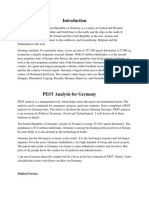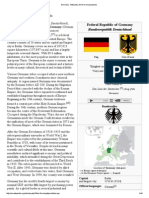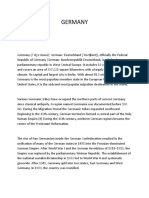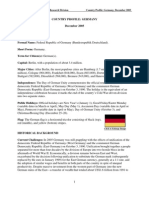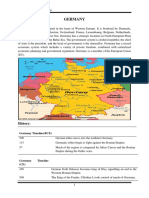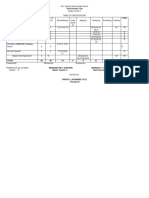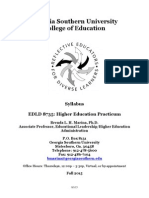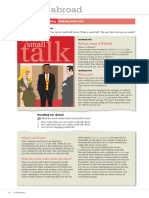Germany (Federal Republic of Germany (German: Bundesrepublik Deutschland
Germany (Federal Republic of Germany (German: Bundesrepublik Deutschland
Uploaded by
SophiaCopyright:
Available Formats
Germany (Federal Republic of Germany (German: Bundesrepublik Deutschland
Germany (Federal Republic of Germany (German: Bundesrepublik Deutschland
Uploaded by
SophiaOriginal Description:
Original Title
Copyright
Available Formats
Share this document
Did you find this document useful?
Is this content inappropriate?
Copyright:
Available Formats
Germany (Federal Republic of Germany (German: Bundesrepublik Deutschland
Germany (Federal Republic of Germany (German: Bundesrepublik Deutschland
Uploaded by
SophiaCopyright:
Available Formats
Germany (German: Deutschland, German pronunciation: [ˈdɔʏtʃlant]), officially the
Federal Republic of Germany (German: Bundesrepublik Deutschland,
listen (help·info)),[g] is a country in Central and Western Europe, lying between the
Baltic and North Seas to the north, and the Alps, Lake Constance and the High Rhine
to the south. It borders Denmark to the north, Poland and the Czech Republic to the
east, Austria and Switzerland to the south, France to the southwest, and Luxembourg,
Belgium and the Netherlands to the west.
Germany includes 16 constituent states, covers an area of 357,386 square kilometres
(137,988 sq mi),[6] and has a largely temperate seasonal climate. With 83 million
inhabitants, it is the second most populous state of Europe after Russia, the most
populous state lying entirely in Europe, as well as the most populous member state of
the European Union. Germany is a very decentralised country. Its capital and largest
metropolis is Berlin, while Frankfurt serves as its financial capital and has the
country's busiest airport. Germany's largest urban area is the Ruhr, with its main
centres of Dortmund and Essen. The country's other major cities include Hamburg,
Munich, Cologne, Stuttgart, Düsseldorf, Leipzig, Dresden, Bremen, Hannover,
Nuremberg, and Mannheim.
Various Germanic tribes have inhabited the northern parts of modern Germany since
classical antiquity. A region named Germania was documented before AD 100.
During the Migration Period, the Germanic tribes expanded southward. Beginning in
the 10th century, German territories formed a central part of the Holy Roman
Empire.[12] During the 16th century, northern German regions became the centre of
the Protestant Reformation. After the collapse of the Holy Roman Empire, the
German Confederation was formed in 1815. The German revolutions of 1848–49
resulted in the Frankfurt Parliament establishing major democratic rights.
In 1871, Germany became a nation state when most of the German states unified
(except Switzerland and Austria) into the Prussian-dominated German Empire. After
World War I and the revolution of 1918–19, the Empire was replaced by the
parliamentary Weimar Republic. The Nazi seizure of power in 1933 led to the
establishment of a dictatorship, the annexation of Austria, World War II, and the
Holocaust. After the end of World War II in Europe and a period of Allied
occupation, Austria was re-established as an independent country and two new
German states were founded: West Germany, formed from the American, British, and
French occupation zones, and East Germany, formed from the Soviet occupation
zone. About a quarter of Germany's pre-war territory was annexed by Poland and the
Soviet Union leading to the explusion of Germans. Following the Revolutions of 1989
that ended communist rule in Central and Eastern Europe, the country was reunified
on 3 October 1990.[13]
Today, the sovereign state of Germany is a federal parliamentary republic led by a
chancellor. It is a great power with a strong economy; it has the world's fourth-largest
economy by nominal GDP, and the fifth-largest by PPP. As a global leader in several
industrial and technological sectors, it is both the world's third-largest exporter and
importer of goods. As a developed country with a very high standard of living, it
upholds a social security and universal health care system, environmental protection,
and a tuition-free university education.
The Federal Republic of Germany was a founding member of the European Economic
Community in 1957 and the European Union in 1993. It is part of the Schengen Area
and became a co-founder of the Eurozone in 1999. Germany is a member of the
United Nations, NATO, the G7, the G20, and the OECD. Known for its rich cultural
history, Germany has been continuously the home of influential and successful artists,
philosophers, musicians, film people, sportspeople, entrepreneurs, scientists,
engineers, and inventors. Germany has a large number of World Heritage sites and is
among the top tourism destinations in the world.
You might also like
- Complete Spanish The Basics by Living Language ExcerptDocument32 pagesComplete Spanish The Basics by Living Language Excerptharshathecool413100% (1)
- Hinduism and Nature - Nanditha KrishnaDocument237 pagesHinduism and Nature - Nanditha KrishnaKelsie Jackson100% (4)
- AK Forbidden - Health Protocol K enDocument3 pagesAK Forbidden - Health Protocol K enKhiemNo ratings yet
- Basic Information On The European UnionDocument11 pagesBasic Information On The European UnionPaulaAbut100% (1)
- Germany (Germany (German: Bundesrepublik DeutschlandDocument1 pageGermany (Germany (German: Bundesrepublik DeutschlandAzreen Anis azmiNo ratings yet
- Germany (Germany (German: Bundesrepublik DeutschlandDocument1 pageGermany (Germany (German: Bundesrepublik DeutschlandOrgito LekaNo ratings yet
- Germany (Germany,: PronouncedDocument1 pageGermany (Germany,: PronouncedAdrian ChirobociaNo ratings yet
- Germany HistoryDocument2 pagesGermany HistoryscrpNo ratings yet
- გერმანიაDocument1 pageგერმანიაdachi apkhazavaNo ratings yet
- GermanyDocument1 pageGermanyzabihullahkhoshbinNo ratings yet
- Quite EasyDocument1 pageQuite EasyMahir CayanNo ratings yet
- Descripcion de Alemania en InglesDocument1 pageDescripcion de Alemania en InglesAlan Hidekel Arcos ZapataNo ratings yet
- Germany 22Document1 pageGermany 22mitko zurkelaNo ratings yet
- 23121Document1 page23121mitko zurkelaNo ratings yet
- Germany Federal Republic of Germany: Deutschland Bundesrepublik DeutschlandDocument1 pageGermany Federal Republic of Germany: Deutschland Bundesrepublik Deutschlandpam tubigNo ratings yet
- Security Council Delegation of GermanyDocument3 pagesSecurity Council Delegation of GermanyArianna GrelaNo ratings yet
- Germany: Federal Republic of GermanyDocument37 pagesGermany: Federal Republic of GermanyPins Sticker InaNo ratings yet
- Synopsis On GermanyDocument3 pagesSynopsis On GermanyakilikesNo ratings yet
- Germany (Germany (German: Bundesrepublik DeutschlandDocument1 pageGermany (Germany (German: Bundesrepublik DeutschlandRakesh PaulNo ratings yet
- GermanyDocument2 pagesGermanyrajeshdraneNo ratings yet
- Wa0000Document9 pagesWa0000ANCHAL SINGHNo ratings yet
- Political FactorsDocument11 pagesPolitical FactorsANCHAL SINGHNo ratings yet
- Germany (Germany (German: Bundesrepublik DeutschlandDocument1 pageGermany (Germany (German: Bundesrepublik Deutschlandakash nairNo ratings yet
- Germany: Federal Republic of GermanyDocument61 pagesGermany: Federal Republic of GermanyschuldnerNo ratings yet
- GermanyDocument1 pageGermanyK EV INNo ratings yet
- East and West GermanyDocument5 pagesEast and West GermanysaifNo ratings yet
- Germany - Wikipedia, The Free EncyclopediaDocument44 pagesGermany - Wikipedia, The Free EncyclopediaRoberto WallisNo ratings yet
- Referat Germania Document Microsoft Word NouDocument1 pageReferat Germania Document Microsoft Word NouiulliakittyNo ratings yet
- Germany: Navigation SearchDocument5 pagesGermany: Navigation SearchȘova AngelicaNo ratings yet
- BAHTIARDocument3 pagesBAHTIARRando WidodoNo ratings yet
- A. Person B. Folk C. Institution D. ManufactureDocument1 pageA. Person B. Folk C. Institution D. ManufactureAdd MienNo ratings yet
- Austria (Republic of Austria (German: Republik Österreich,: GermanyDocument2 pagesAustria (Republic of Austria (German: Republik Österreich,: GermanyȘova AngelicaNo ratings yet
- Germany: Bundesrepublik DeutschlandDocument36 pagesGermany: Bundesrepublik DeutschlandVidushi KhajuriaNo ratings yet
- Austria (: Listen Help InfoDocument2 pagesAustria (: Listen Help InfoIrina TurcanuNo ratings yet
- EuroPol (Final Paper)Document11 pagesEuroPol (Final Paper)Crizalyn FloraNo ratings yet
- GermanyDocument1 pageGermany彭可翰No ratings yet
- GermanyDocument1 pageGermanyalkamli6307No ratings yet
- WP 2.1 Delivery by Team 18 MIT1HDDocument5 pagesWP 2.1 Delivery by Team 18 MIT1HDmanhpv_hd100% (2)
- Germany - WikipediaDocument45 pagesGermany - Wikipediammac.moinNo ratings yet
- DER3470 Advanced German Broad Course NotesDocument3 pagesDER3470 Advanced German Broad Course NotesJohannes WeinerNo ratings yet
- GermanyDocument2 pagesGermanyPetru ZuzaNo ratings yet
- Culture Presentation-Germany: Keshav Kesher Ronak Rutvi Saurabh Shantanu Vibhor VivekDocument42 pagesCulture Presentation-Germany: Keshav Kesher Ronak Rutvi Saurabh Shantanu Vibhor VivekShakti TandonNo ratings yet
- GermaniaDocument3 pagesGermaniaVladRaileanuNo ratings yet
- Germany: Referat - ClopotelDocument4 pagesGermany: Referat - ClopotelCristina SolomonNo ratings yet
- Germany 1Document51 pagesGermany 1anurssbNo ratings yet
- Foreign Relations of GermanyDocument12 pagesForeign Relations of Germanyalexutza_matza882161No ratings yet
- Library of Congress - Federal Research Division Country Profile: Germany, December 2005Document25 pagesLibrary of Congress - Federal Research Division Country Profile: Germany, December 2005420100% (1)
- Germany PresentationDocument16 pagesGermany Presentationapi-385486997No ratings yet
- Case Study 122 7Document2 pagesCase Study 122 7jen luNo ratings yet
- What are the Countries in the European Union? Geography Books for Kids | Children's Geography & Culture BooksFrom EverandWhat are the Countries in the European Union? Geography Books for Kids | Children's Geography & Culture BooksNo ratings yet
- Intro and History of GermanyDocument13 pagesIntro and History of GermanyHaider KhanNo ratings yet
- GERMANYDocument26 pagesGERMANYareebNo ratings yet
- Alemania GeopolitaDocument17 pagesAlemania GeopolitaMauricio Vargas MNo ratings yet
- Munich Airport Again Proved Popular With Survey Respondents Finishing in Sixth Place inDocument10 pagesMunich Airport Again Proved Popular With Survey Respondents Finishing in Sixth Place inabhisheklt26iNo ratings yet
- Germany: Referat - ClopotelDocument5 pagesGermany: Referat - ClopotelDarius CuceaNo ratings yet
- 2Document8 pages2Grozeanu OctavianNo ratings yet
- Germany From A To ZDocument11 pagesGermany From A To ZSebastian GómezNo ratings yet
- Crop Video To 0:11 Topics: Germany's Impact On UAE: German Empire - Deutsches KaiserreichDocument4 pagesCrop Video To 0:11 Topics: Germany's Impact On UAE: German Empire - Deutsches KaiserreichSohan PrasadNo ratings yet
- Germany: Federal Republic of GermanyDocument5 pagesGermany: Federal Republic of GermanyANTHONY WAYNENo ratings yet
- Germany HistoryDocument2 pagesGermany Historyqaiserfiaz11No ratings yet
- Federal Republic of DeutchlandDocument5 pagesFederal Republic of DeutchlandKevin Millán100% (1)
- Grade 3 Geometry Classify TrianglesDocument2 pagesGrade 3 Geometry Classify TrianglesSophiaNo ratings yet
- Florida (: ListenDocument2 pagesFlorida (: ListenSophiaNo ratings yet
- Grade 3 Roman Numerals Write 1 50 FDocument2 pagesGrade 3 Roman Numerals Write 1 50 FSophiaNo ratings yet
- Grade 3 Roman Numerals Write 1 50 eDocument2 pagesGrade 3 Roman Numerals Write 1 50 eSophiaNo ratings yet
- Won't You Celebrate With MeDocument1 pageWon't You Celebrate With MeSophiaNo ratings yet
- Louisiana (: Listen ListenDocument1 pageLouisiana (: Listen ListenSophiaNo ratings yet
- Los Angeles (: ListenDocument1 pageLos Angeles (: ListenSophiaNo ratings yet
- California Is ADocument2 pagesCalifornia Is ASophiaNo ratings yet
- Chicago (: Locally AlsoDocument2 pagesChicago (: Locally AlsoSophiaNo ratings yet
- BostonDocument1 pageBostonSophiaNo ratings yet
- Honoré de Balzac (: - Zak - La Comédie Humaine Magnum OpusDocument1 pageHonoré de Balzac (: - Zak - La Comédie Humaine Magnum OpusSophiaNo ratings yet
- Les Misérables The Hunchback of Notre-Dame Les Contemplations La Légende Des Siècles Cromwell Hernani Notre-Dame de Paris Les MisérablesDocument1 pageLes Misérables The Hunchback of Notre-Dame Les Contemplations La Légende Des Siècles Cromwell Hernani Notre-Dame de Paris Les MisérablesSophiaNo ratings yet
- VoltaireDocument1 pageVoltaireSophiaNo ratings yet
- FrançoisDocument1 pageFrançoisSophiaNo ratings yet
- FrançoisDocument1 pageFrançoisSophiaNo ratings yet
- Charles Pierre BaudelaireDocument1 pageCharles Pierre BaudelaireSophiaNo ratings yet
- Émile Édouard Charles Antoine ZolaDocument1 pageÉmile Édouard Charles Antoine ZolaSophiaNo ratings yet
- The Sun Rising Poem AnalysisDocument7 pagesThe Sun Rising Poem AnalysisTM100% (1)
- AP Psych SyllabusDocument140 pagesAP Psych SyllabusAlex JinNo ratings yet
- Annisette (2017) Discourse of The Professions The Making, Normalizing and Taming of Ontario's Foreign Trained AccountantDocument25 pagesAnnisette (2017) Discourse of The Professions The Making, Normalizing and Taming of Ontario's Foreign Trained AccountantPhoranee Kob RhuwadhanaNo ratings yet
- BarsisaDocument3 pagesBarsisaadadarahim6778No ratings yet
- Charlie ChanDocument2 pagesCharlie ChanChristopher BrayNo ratings yet
- Precarious Communism: Manifest Mutations, Manifesto DetournedDocument151 pagesPrecarious Communism: Manifest Mutations, Manifesto DetournedMinor Compositions100% (3)
- Tips in Designing RubricsDocument2 pagesTips in Designing RubricsJay-ar JaneoNo ratings yet
- Student Score Grade 6 2016-2017Document35 pagesStudent Score Grade 6 2016-2017EpiNuryantiNo ratings yet
- MT Chapter 02Document8 pagesMT Chapter 02Ahmad RezaNo ratings yet
- TargetLink AUTOSAR GuidelinesDocument72 pagesTargetLink AUTOSAR GuidelinesczgNo ratings yet
- LE Language Q1 Wk5 v2Document21 pagesLE Language Q1 Wk5 v2SEVERINA ACCADNo ratings yet
- Daily Lesson Plan: School Grade LevelDocument2 pagesDaily Lesson Plan: School Grade LevelMaymay TotNo ratings yet
- Third Periodic Test: Principal IIIDocument3 pagesThird Periodic Test: Principal IIISandra QS MembrereNo ratings yet
- Edld 8735 Fall 2015 SyllabusDocument17 pagesEdld 8735 Fall 2015 Syllabusapi-285702156No ratings yet
- FOCGB4 Utest VG 1ADocument1 pageFOCGB4 Utest VG 1AMarija33% (3)
- The Effects of Internet Censorship To High School StudentsDocument9 pagesThe Effects of Internet Censorship To High School Studentsimkrstnsnts100% (2)
- Application For Privilege To Study at Reduced FeesDocument1 pageApplication For Privilege To Study at Reduced FeesAriel Dela CruzNo ratings yet
- State of Bombay V RMDCDocument35 pagesState of Bombay V RMDCSudhir Kochhar Fema AuthorNo ratings yet
- Hangul AlphabetDocument7 pagesHangul AlphabetivcbeautyNo ratings yet
- Explanation TextDocument11 pagesExplanation TextWidyalegaranoNo ratings yet
- The - Business - PI - SB 12Document1 pageThe - Business - PI - SB 12Agrafena GrekNo ratings yet
- Soal Bahasa Inggriskelas Xi Lintas Minat Ujian Semester Ganjil 2019Document12 pagesSoal Bahasa Inggriskelas Xi Lintas Minat Ujian Semester Ganjil 2019Desi SuryaniNo ratings yet
- 2018 Cambridge Secondary Lower Progression Test Maths Stage 9 QP Paper 1 - tcm143-430400Document12 pages2018 Cambridge Secondary Lower Progression Test Maths Stage 9 QP Paper 1 - tcm143-430400noor fatim0% (1)
- Criminal Law 2 Study Guide April 30Document13 pagesCriminal Law 2 Study Guide April 30poppy2890No ratings yet
- cw1 - CU6051NA - Artificial Intelligence - Ashish - Bhandari - 17031918Document19 pagescw1 - CU6051NA - Artificial Intelligence - Ashish - Bhandari - 17031918Movies. PlexNo ratings yet
- ThesisDocument2 pagesThesisRiki CheolsuNo ratings yet
- MOD WEST AssignmentDocument5 pagesMOD WEST Assignmentchaudharyniharika2503No ratings yet




















